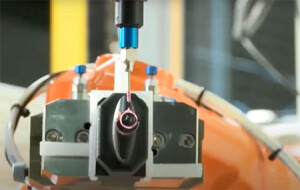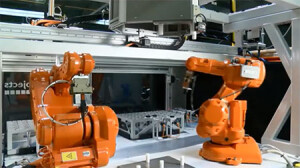Machine vision and robotics solve positioning challenge
 Having a machine ‘see’ a complex shaped part, then manipulate it whilst performing a highly accurate masking application is an example of a unique challenge presented in ‘future manufacturing technology’. For Astech Projects engineers, this future technology is all in a day’s work.
Having a machine ‘see’ a complex shaped part, then manipulate it whilst performing a highly accurate masking application is an example of a unique challenge presented in ‘future manufacturing technology’. For Astech Projects engineers, this future technology is all in a day’s work.
In 2015, Astech Projects was approached by an aerospace manufacturer that needed assistance with a key manufacturing process problem. The manufacturer was involved in developing an automated process but was struggling to achieve the accuracy and consistency required.
The Astech Projects team was able to solve the problem with a novel application that combined sophisticated machine vision and robotics for the first time for the manufacturer. Accuracy was vital for this project which involved both critical high-performance aerospace components and expensive precious metals.
At the time, the process relied on skilled labour manually painting the component to apply the masking material. The manufacturer wanted to improve consistency and throughput and therefore sought to automate the laborious process.
Existing techniques had focused on the use of sensors to identify part position and alignment. However, this didn’t deliver the required level of accuracy. The manufacturer therefore approached Astech Projects to see what we could do to solve the problem.
The initial proof of concept (PoC) work kicked off in 2015. It was soon concluded that using machine vision in combination with the laser sensors would be the best way to establish the position and alignment of the component. Within two months of the original contact from the manufacturer Astech Projects was able to successfully demonstrate the vision and robotic system accurately adjusting and positioning the component to allow accurate maskant dispensing from a fixed point.
During PoC the repeatability of the process was proved with the use of a dial test indicator (DTI) before getting agreement from the client to begin work on the fully automated system.
“It was a really exciting project for our engineers to work on – combining the two technologies of machine vision and robotics in this way – and solving the problem of positional accuracy was a significant challenge,” says Craig Hamilton, Astech Projects’ business development manager. “The client’s expectation was exceeded with the result – but then came the difficult part: scaling up to 14 different variations and integrating two robots without compromising accuracy.”
 Multiple variations and two robots
Multiple variations and two robots
The solution Astech Projects had designed and created used machine vision to locate the component in a point in space, confirm the geometry of the part and its position, and then apply a masking material to the object with an accuracy of within 0.1mm.
The goal had been 0.2mm tolerance, so the team – both at Astech Projects and at the client site – were immensely pleased with the result. However, the challenge of maintaining this accuracy when two robots worked in unison elevated the complexity of scaling up from proof of concept to a fully automated system. This was because both system and components had their own accuracy tolerances – for example, in the joints of the robot, the component or the storage positions. These inaccuracies compound across the whole process to create a difficult engineering challenge.
“Using the same program for each robot was essential from a replicability point of view, both for us and for the client,” explains Hamilton. “It helps in terms of programming efficiency and, therefore, cost of upgrades and maintenance and it also helps the client in terms of validation. It requires a lot of testing to get right, but to solve the problem we were able to create machine vision tools to help us with the alignment of the robots as well.”
Successful operation delivers improved throughput
The automated system has now been in successful operation for six months. “It has been extremely well-received by the client,” says Hamilton. “We believe our robots are now a high spot on tours of the site for company VIPs. Importantly, they are delivering the required level of accuracy and consistency for the client. What’s more, the client has been able to improve throughput significantly through 24/7 operation.”
The client will be rolling out the new robot and machine vision production system to other sites across the UK and since the application uses Astech Projects’ own control and automation software and technical expertise, Astech Projects will be repeating the builds.
Hamilton continues: “We’re now one of five automation companies approved by the organisation globally, and we are already in discussions for other complex turnkey projects. Importantly, this unique application of machine vision and robotics has further potential to help other clients in other industries and in other applications. In particular, it would be applicable for coating, gluing, spraying or other processes where a liquid is applied.
“Indeed, this combination of technologies could be useful in any application where a component with complex geometry needs to be located with a high level of accuracy.”
Visit the Astech Projects website for more information
See all stories for Astech Projects















